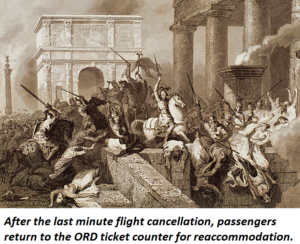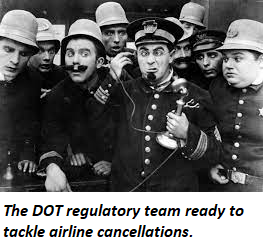Before We Start This Week…
Clear Your Calendar For This Friday, July 1
Time for some clear, direct and politically-incorrect discussion of today’s air service chaos.
This Friday, July 1, we’re posting the next Vox Deorum discussion on our Aviation Unscripted™ video channel. This is where we bring in an industry expert to explore heavy aviation issues.
This week were doing a no-holds-barred discussion with our friend Kathryn Creedy, editor in chief of Future Aviation/Aerospace Workforce News, and one of the nation’s most insightful experts on regional and national air service issues.
 Right now, just about every problem in air travel, regardless of what it is, seems to be attributed to the pilot shortage.
Right now, just about every problem in air travel, regardless of what it is, seems to be attributed to the pilot shortage.
Flight cancellations, delays, diversions, security lines, small community service cuts- you name it, and the news stories will categorize it as due to lack of pilots.
Wrong – there’s a lot more to it than that. This Friday, we’ll be exploring it – no holds barred – with Kathryn. We’ll be discussing verboten topics like the 1,500 hour rule and what it represents or doesn’t represent in terms of aviation policy. We’ll be cutting into the foundation of today’s airport chaos, naming names and stating facts.
So, if you’re interested in getting perspectives that relate to reality, instead of the “consensus,” log on to Aviation Unscripted™ first thing this Friday.
In the meantime, take a look at the current Aviation Unscripted video now on line– it expands on the Three Dynamics we’re discussing below, and touches on the core issues we’ll be exploring in this Friday’s Vox Deorum session. It will be posted initially on our Rumble channel at 9AM ET.
_______________
The Three Key Emerging Air Service Dynamics
To read some of the media coverage, the air transportation industry is in a record boom situation, with hordes of passengers overwhelming airports across the country like medieval Visigoths in the process of sacking Rome.
 The stories of airport chaos, cancellations, long lines and confusion are front and center, with the implication repeatedly stated in the media that record demand combined with a “pilot shortage” are the culprits.
The stories of airport chaos, cancellations, long lines and confusion are front and center, with the implication repeatedly stated in the media that record demand combined with a “pilot shortage” are the culprits.
Neither are accurate… which is the reason airport planning needs to shift into full metal jacket mode to accommodate major shifts coming in airline strategies and consumer patterns.
There are three core dynamics in play.
Dynamic #1
Traffic Levels Still Below Pre-CCP Pandemic Levels. As it stands today – and it’s likely to drop in the second half of 2022 – the nation’s airport system will handle @ 12% fewer enplanements than in 2019. Fewer, not more.
To be clear, there are some airports that are blessedly seeing higher than pre-pandemic enplanements. That’s great, but a hard look at some (not all, certainly) of these indicate that the growth is based on spikes in leisure travel capacity.
With a reported 8.5% inflation – more likely closer to 12% for key consumer items – some of these airports that are highly-dependent on leisure traffic – particularly ULCC impulse leisure consumers – should take a hard look at potential changes in revenue streams in the next 12 months.
Think about it. When some reports claim that 40% of households are using savings to pay bills, leisure traffic just might move down the priority list, ya think?
Think about it. When there is an increasing consensus that we are heading for – or are already in – a recession, spend on travel might just get red-lined out of the company budget.
The point here is that the traffic growth – be it “pent up” or “revenge” or whatever the buzzword may be – could slow materially in the coming months.
Dynamic #2
It’s About Highest & Best Use of All Resources. Not Just Pilots. Then there are the misconceptions regarding the pilot situation.
Places like Dubuque and Toledo have lost all commercial air service not because of a shortage of cockpit crews, per se. Instead, airlines are not going to apply resources – pilots, cash, fuel, ground staff, etc. – in markets that can’t any longer deliver an adequate return.
The raw economics of $4 jet-A, higher labor costs, and the fact that the local airport may not be what consumers determine to be the best air gateway option (as in the case of Toledo) have combined to make a lot of routes economic dogs, and in the process accelerate the retirement of smaller airliners – read: 50-seat jets.
 Naturally, we can depend on some of the vapor-weights in the media to keep us misinformed. A really stupid article in the Washington Examiner (likely with a readership up there with paperback cookbooks) recently recounted the dire future that Toledo now faces being cut off without local air service. Loss of businesses, trapped consumers and economic devastation.
Naturally, we can depend on some of the vapor-weights in the media to keep us misinformed. A really stupid article in the Washington Examiner (likely with a readership up there with paperback cookbooks) recently recounted the dire future that Toledo now faces being cut off without local air service. Loss of businesses, trapped consumers and economic devastation.
The fact that consumers have had and still have their main air gateway at Detroit – which is the main reason for AA taking a powder at Toledo – is beyond the ability of some reporters to research. Caveat reader.
Point: the airline industry has an airplane shortage. More specifically, a permanent shortage of airliners with the economics to continue to access some markets.
This means regionalization of air service access… in many cases a regionalization process that’s already established. In other cases, it will entail some political gumption for communities to craft programs that maximize consumer understanding of air access realities.
Dynamic #3
Airlines Selling Product Without Product Support. The chaos at airports is mainly driven by the inability of airlines to recover from off-schedule events.
Regardless of the reasons, the emerging image is a situation where customers are orphaned as soon as a flight cancels or a delay causes a misconnect.
As we point out in the current Aviation Unscripted video, it is not uncommon for flights to be cancelled at the last minute, with the airline (and we’re talking network carriers) grandly telling the passengers that they’ve been automatically re-booked. But on a flight two days later.
 And, in light of the fact that recovery from off-sched operations can be this extensive, there is zero excuse for airlines not to be prepared to deal with customers. Hour long and longer phone waits are strictly Third World – which, unfortunately, is where some carriers’ call centers are located. (It’s cheaper, see.)
And, in light of the fact that recovery from off-sched operations can be this extensive, there is zero excuse for airlines not to be prepared to deal with customers. Hour long and longer phone waits are strictly Third World – which, unfortunately, is where some carriers’ call centers are located. (It’s cheaper, see.)
Consumers are trapped. This could lead to a much worse situation – getting the feds involved in developing new rules to “force” airlines to improve.
The usual suspects in the media would be jumping puppies at the thought. But coming from a DOT secretary with zero expertise in transportation (which was the case with most of his predecessors, by the way) any intervention would be mostly political theater.
More Insight On These Dynamics… Invest Eight Minutes For Incisive Perspectives Others Miss.
We’ve covered this on the latest Aviation Unscripted™ video. It’s direct, to the point, and delivers insight that goes beyond consensus thinking.
Among other things, we outline the four air traffic segments that are in the cross hairs of rising inflation.
Click here to join us! And while you’re there, subscribe to get updates when new Unscripted videos are posted.
____________